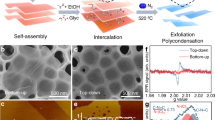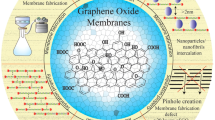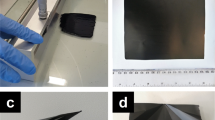Abstract
Graphene oxide (GO) membranes offer high selectivity and energy-efficient gas separation. However, their dense, layered structure and tortuous diffusion paths limit permeability, posing a barrier to industrial use. Here we present a method to enhance selectivity and permeability, maintaining the structural stability of such membranes. With an industrially friendly manufacturing method, we produce crumpled GO membranes with gas diffusion pathways controlled by a multidomain structure. These membranes achieve H2 permeability of approximately 2.1 × 104 barrer, significantly surpassing the permeability of flat lamellar GO membranes, which is below 100 barrer. Its H2/CO2 selectivity of 91 outperforms current membrane technologies. In addition, the crumpled membranes demonstrate stability under harsh conditions (−20 °C, 96% relative humidity), a critical requirement for practical applications. This work addresses the long-standing permeability–selectivity trade-off and establishes a robust, scalable platform for integrating two-dimensional materials into membrane technology for real-world applications.
This is a preview of subscription content, access via your institution
Access options
Access Nature and 54 other Nature Portfolio journals
Get Nature+, our best-value online-access subscription
$32.99 / 30 days
cancel any time
Subscribe to this journal
Receive 12 print issues and online access
$259.00 per year
only $21.58 per issue
Buy this article
- Purchase on SpringerLink
- Instant access to full article PDF
Prices may be subject to local taxes which are calculated during checkout




Similar content being viewed by others
Data availability
All data supporting the findings of this study are available within the article and its Supplementary Information. Additional raw data are available from the corresponding author upon reasonable request.
References
Sun, P. Z. et al. Limits on gas impermeability of graphene. Nature 579, 229–232 (2020).
Kim, H. W. et al. Selective gas transport through few-layered graphene and graphene oxide membranes. Science 342, 91–95 (2013).
Chen, M. et al. Comprehensive characterization of gas diffusion through graphene oxide membranes. J. Membr. Sci. 676, 121583 (2023).
Li, H. et al. Ultrathin, molecular-sieving graphene oxide membranes for selective hydrogen separation. Science 342, 95–98 (2013).
Polotskaya, G. A., Andreeva, D. V. & El’yashevich, G. K. Investigation of gas diffusion through films of fullerene-containing poly(phenylene oxide). Tech. Phys. Lett. 25, 555–557 (1999).
Ding, L. et al. MXene molecular sieving membranes for highly efficient gas separation. Nat. Commun. 9, 155 (2018).
Chen, M. et al. Control of gas selectivity and permeability through COF-GO composite membranes for sustainable decarbonization and hydrogen production. Carbon 219, 118855 (2024).
Peng, Y. et al. Metal–organic framework nanosheets as building blocks for molecular sieving membranes. Science 346, 1356–1359 (2014).
Wang, X. et al. Reversed thermo-switchable molecular sieving membranes composed of two-dimensional metal–organic nanosheets for gas separation. Nat. Commun. 8, 14460 (2017).
Rooney, A. P. et al. Anomalous twin boundaries in two dimensional materials. Nat. Commun. 9, 3597 (2018).
Cranford, S. W. & Buehler, M. J. Packing efficiency and accessible surface area of crumpled graphene. Phys. Rev. B 84, 205451 (2011).
Haddad, K. et al. Crumpled graphene oxide for enhanced room temperature gas sensing: understanding the critical roles of surface morphology and functionalization. J. Mater. Chem. A 11, 447–459 (2023).
Luo, J. et al. Compression and aggregation-resistant particles of crumpled soft sheets. ACS Nano 5, 8943–8949 (2011).
Landau, L. D. & Lifshitz, E. M. Theory of Elasticity (Pergamon, 1970).
Meshhal, M. & Kühn, O. Diffusion of water confined between graphene oxide layers: implications for membrane filtration. ACS Appl. Nano Mater. 5, 11119–11128 (2022).
Mouhat, F., Coudert, F.-X. & Bocquet, M.-L. Structure and chemistry of graphene oxide in liquid water from first principles. Nat. Commun. 11, 1566 (2020).
Chen, M. et al. Large-scale self-assembly of anisotropic graphene oxide films via blade coating: sustainable design and stimuli-responsive performance for biomimicry. Mater. Des. 233, 112205 (2023).
Ma, X., Zachariah, M. R. & Zangmeister, C. D. Crumpled nanopaper from graphene oxide. Nano Lett. 12, 486–489 (2012).
Wang, W.-N., Jiang, Y. & Biswas, P. Evaporation-induced crumpling of graphene oxide nanosheets in aerosolized droplets: confinement force relationship. J. Phys. Chem. Lett. 3, 3228–3233 (2012).
Song, S. et al. Facile synthesis of crumpled graphene oxide and its outstanding electrochemical performance as an anode in lithium ion batteries. J. Electron. Mater. 52, 877–886 (2023).
Kang, Y. et al. The role of nanowrinkles in mass transport across graphene‐based membranes. Adv. Funct. Mater. 30, 2003159 (2020).
Zhang, P. et al. Stress driven micron- and nano-scale wrinkles as a new class of transport pathways of two-dimensional laminar membranes towards molecular separation. J. Membr. Sci. 648, 120354 (2022).
Gabardo, C. M., Yang, J., Smith, N. J., Adams-McGavin, R. C. & Soleymani, L. Programmable wrinkling of self-assembled nanoparticle films on shape memory polymers. ACS Nano 10, 8829–8836 (2016).
Robeson, L. M. The upper bound revisited. J. Membr. Sci. 320, 390–400 (2008).
Wang, R. et al. Pyro-layered heterostructured nanosheet membrane for hydrogen separation. Nat. Commun. 14, 2161 (2023).
Wang, S. et al. A highly permeable graphene oxide membrane with fast and selective transport nanochannels for efficient carbon capture. Energy Environ. Sci. 9, 3107–3112 (2016).
Li, P. et al. Continuous crystalline graphene papers with gigapascal strength by intercalation modulated plasticization. Nat. Commun. 11, 2645 (2020).
Zang, J. et al. Multifunctionality and control of the crumpling and unfolding of large-area graphene. Nat. Mater. 12, 321–325 (2013).
Katsnelson, M. I. The Physics of Graphene 2nd edn (Cambridge Univ. Press, 2020).
Davidovitch, B. & Guinea, F. Indentation of solid membranes on rigid substrates with van der Waals attraction. Phys. Rev. E 103, 043002 (2021).
Cerda, E. & Mahadevan, L. Geometry and physics of wrinkling. Phys. Rev. Lett. 90, 074302 (2003).
Hure, J., Roman, B. & Bico, J. Stamping and wrinkling of elastic plates. Phys. Rev. Lett. 109, 054302 (2012).
Mezard, M., Parisi, G. & Virasoro, M. A. World Scientific Lecture Notes in Physics Vol. 9 (World Scientific, 1987).
Principi, A. & Katsnelson, M. I. Stripe glasses in ferromagnetic thin films. Phys. Rev. B 93, 054410 (2016).
Mauri, A. & Katsnelson, M. I. Frustrated magnets in the limit of infinite dimensions: dynamics and disorder-free glass transition. Phys. Rev. B 109, 144414 (2024).
Kamber, U. et al. Self-induced spin glass state in elemental and crystalline neodymium. Science 368, eaay6757 (2020).
Plummer, A., Hanakata, P. Z. & Nelson, D. R. Curvature as an external field in mechanical antiferromagnets. Phys. Rev. Mater. 6, 115203 (2022).
Savini, G. et al. Bending modes, elastic constants and mechanical stability of graphitic systems. Carbon 49, 62–69 (2011).
Abraham, J. et al. Tunable sieving of ions using graphene oxide membranes. Nat. Nanotechnol. 12, 546–550 (2017).
Joshi, R. K. et al. Precise and ultrafast molecular sieving through graphene oxide membranes. Science 343, 752–754 (2014).
Acknowledgements
This research is supported by the Ministry of Education, Singapore, under its Research Centre of Excellence award to the Institute for Functional Intelligent Materials (I-FIM, project no. EDUNC-33-18-279V12). We thank C. Wong from KEYENCE SINGAPORE PTE LTD. for his assistance with spatial microscopy of cGO membranes using the VHX-7000 digital microscope. A.U. acknowledges funding from the Materials Generative Design and Testing Framework (MAT-GDT) programme at A*STAR, provided through the AME Programmatic Fund (grant no. M24N4b0034). K.S.N. acknowledges support from the National Research Foundation, Singapore under its AI Singapore Programme (AISG award no. AISG3-RP-2022-028) and from the Royal Society (UK, grant no. RSRP\R\190000).
Author information
Authors and Affiliations
Contributions
D.V.A. conceived and designed the study. P.Z., Q.W., Y.Z., M.L., X.Z., M.C. and M.T. carried out the experiments. P.Z., M.T., A.D. and A.U. performed the data collection and analysis. P.Z., Q.W., M.T., M.I.K., K.S.N. and D.V.A. contributed to the development of the mechanochemical approach. P.Z., M.T., M.I.K., K.S.N. and D.V.A. wrote the paper with input from all authors. D.V.A. supervised the project and provided overall guidance. All authors discussed the results and contributed to the final paper.
Corresponding author
Ethics declarations
Competing interests
The authors declare no competing interests.
Peer review
Peer review information
Nature Nanotechnology thanks Haiqing Lin, Weishen Yang and the other, anonymous, reviewer(s) for their contribution to the peer review of this work.
Additional information
Publisher’s note Springer Nature remains neutral with regard to jurisdictional claims in published maps and institutional affiliations.
Supplementary information
Supplementary Information
Supplementary Figs. 1–25, Tables 1–3 and discussion.
Supplementary Video
Formation of cGO membranes during thermal shrinkage of polymer support.
Rights and permissions
Springer Nature or its licensor (e.g. a society or other partner) holds exclusive rights to this article under a publishing agreement with the author(s) or other rightsholder(s); author self-archiving of the accepted manuscript version of this article is solely governed by the terms of such publishing agreement and applicable law.
About this article
Cite this article
Zhang, P., Wang, Q., Zhang, Y. et al. Strain-induced crumpling of graphene oxide lamellas to achieve fast and selective transport of H2 and CO2. Nat. Nanotechnol. 20, 1254–1261 (2025). https://doi.org/10.1038/s41565-025-01971-8
Received:
Accepted:
Published:
Issue date:
DOI: https://doi.org/10.1038/s41565-025-01971-8



